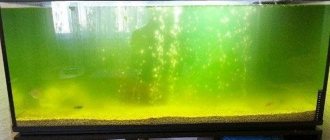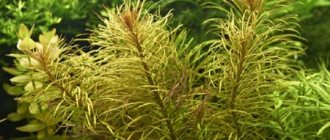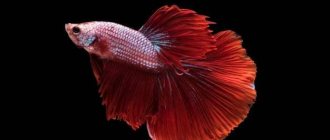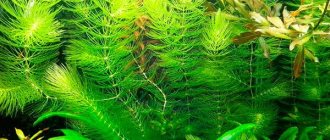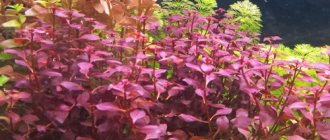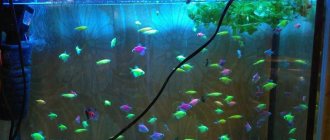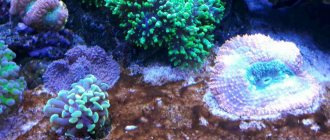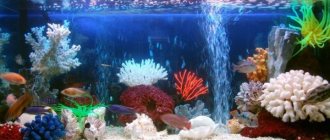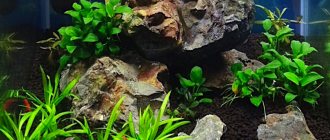Cirrus (Myriophyllum) is a beautiful freshwater plant with a long, straight stem and delicate, feathery leaves. Also known as "urut" or "water yarrow". The first description of this plant was presented by the Swedish naturalist Carl Linnaeus in 1853. The name of the genus Myriophyllum, to which these freshwater plants belong, is translated from Greek as “countless leaves.”
The first pinnates were discovered in South America, off the Amazon coastline. Now these plants are found on all continents of the globe, except Antarctica. They live in freshwater reservoirs with a slow current, at a depth of 0.5-1 m. In clean, well-lit reservoirs they grow at a depth of up to 2 m.
Due to their decorative properties, pinnates are widely used in aquariums and aquascaping. Under favorable conditions, they form dense lacy thickets in the water column.
General information. Habitat
Red-stemmed pinnate is a natural variety of the Brazilian pinnate. The plant's homeland is considered to be North America, Cuba, and Mexico. In its natural habitat it grows in deep and shallow water with clean, clear water. If its level is very low, then the plant becomes emergent. Depending on the conditions, its appearance also differs slightly:
- In the air, the stem is erect, on which there are rugged, feather-like, green leaves with a glossy water-repellent surface.
- Under water, the leaf plates take on a more elegant appearance.
Regardless of where it grows, the stem turns brownish-red even in low light, which is a distinctive feature of this species. Other pinnates require bright light.
Description
The red-stemmed pinnate, a photo of which is presented in the article, can reach a height of fifty centimeters when grown in an aquarium. Depending on the surrounding conditions, its stems and leaves take on a variety of colors. From a straight and thin stem, pinkish or brown leaves extend in different directions, resembling hairs or feathers, collected in whorls. Their arrangement is random, normal whorls are rare. The color of the stem is dark red or reddish brown. The stem needs special care and needs pruning to prevent it from becoming an emergent plant.
The root system is poorly developed. The roots spreading along the surface of the soil are long and very thin. The plant has the ability to grow rapidly, to curb which many people keep special fish who like to feast on this exotic plant.
Keeping red-stemmed pinnate in an aquarium is allowed either free-floating or rooted in the ground. It is planted in groups (two or three bushes) in the background, as it forms dense thickets.
Beneficial properties for the aquarium and its inhabitants
Cirrus has valuable decorative properties. Its tall stems with carved leaves are used to create a magnificent green background in the aquarium.
But attractive appearance is not the main advantage of uruti. This plant is able to purify water from impurities and saturate it with oxygen. Among the feathery leaves, a favorable environment is created for the proliferation of microorganisms that destroy unicellular algae.
Uruti thickets serve as a refuge for fry of viviparous fish, ciliates and other aquatic inhabitants, as well as a substrate for the eggs of spawning fish. Herbivorous fish enjoy juicy, fragile pinnate leaves, which are a valuable addition to their main diet.
Cirrus is a plant that is widely used in the aquarium hobby for background landscaping. It is undemanding to living conditions and has a high growth rate. Propagated by cuttings. Forms dense lacy thickets in the aquarium.
Red cirrus matogros photo
Range: South and North America.
Red matogrossense pinnate (Myriophyllum mattogrossense) is a plant widely distributed among aquarists. Since it is suitable for keeping in an aquarium of any capacity and is relatively unpretentious. The leaf arrangement is whorled, with 5-7 leaves up to 5 cm long, reddish to brown. Plant height up to 60 cm.
Water requirements
The plant is very thermophilic, so it requires special conditions - high temperature in the aquarium. For this reason, it should not be planted with cold-hardy vegetation. In the winter months the temperature should be about 18 degrees, in the summer months - 25 degrees. Clean water is also a necessary condition for its maintenance. It is necessary to change 1/3 of the volume weekly. The following water parameters are considered optimal: acidity - within 6.2–7.2; hardness – from 2 to 14 degrees.
Filtration is required, since the plant does not tolerate various suspensions and dirt particles in the water. They settle on the leaves and interfere with the absorption of nutrients, which can lead to starvation and death. The appearance of the red-stemmed pinnate (Myriophyllum heterophyllum) also deteriorates.
Lighting
The plant loves light, so good lighting in the aquarium is a must. Fluorescent lamps with a power of 0.4 W/l are suitable for these purposes. The duration of daylight is approximately twelve hours. Thanks to it, the leaf blade has a dark green hue, and the stem has a dark or brownish-red tint.
Lack of light has a detrimental effect on the plant, it becomes pale and very elongated. In addition, it should be protected from direct sunlight. When they get on the leaves, the latter lose their attractiveness and brown spots appear on them.
Possible difficulties during cultivation
In direct sunlight, the cirrus quickly becomes covered with brown algae, which suffocate it, prevent it from developing normally and reduce the attractiveness of the plant. To protect the carved leaves from attack by brown algae, it is necessary to prevent direct sunlight from entering the aquarium.
The fragile, succulent leaves of the plant are a delicacy for snails and herbivorous fish: guppies, mollies, barbs, platies, cichlids, and Clarius catfish. Species with thin leaves suffer especially badly from herbivorous fish.
When there is insufficient lighting, the stems of the plant stretch, the leaves turn pale and fall off. To correct the situation, it is necessary to increase the lighting power to 0.4-0.5 W/l.
Soil, fertilizing
The best soil is considered to be coarse river sand with an average degree of siltation. Approximately three centimeters of it is poured onto the bottom of the aquarium. However, if there is gravel at the bottom, then red-stemmed pinnate is planted in small pots. Place them along the walls.
Despite the fact that this crop does not require additional nutrition, to give the bush lushness and brightness, monthly fertilizing with liquid mineral fertilizers and the supply of CO2 is advisable. Experienced aquarists also advise placing a clay ball at the roots of the plant. Thanks to it, the plant will have a reliable root system.
How to plant a plant
Cirrus is an aquarium plant with a poorly developed root system. This does not prevent you from planting it in the ground. Here's how experienced aquarists do it:
- Step 1. The cutting, cut from the mother plant, is allowed to float on the surface of the reservoir for 2-3 weeks.
- Step 2. Make a small hole in the soil and place a ball rolled out of clay on the bottom.
- Step 3. The cutting is placed in the hole and the lower 1-2 whorls with roots are sprinkled with sand.
Whorls are used to propagate cirrus
While the cuttings float on the surface of the pond, small white roots appear. This cutting adapts more easily after planting in the ground.
Red-stemmed pinnate: reviews
Aquarists value this exotic culture for its good decorative qualities. Below are some comments and reviews about this plant:
- with proper care, pinnately forms beautiful thickets;
- this is a rather fragile plant with an amazing color;
- it is important to maintain certain water parameters;
- easy to reproduce;
- has very fast growth;
- besides red-stemmed, there are many other equally interesting species of pinnate;
- It is necessary to maintain ideal cleanliness of the water in the aquarium.
Other types of pinnate
Several varieties of this unusual plant are known. Let's look at some of them:
- Christmas tree is easy to care for and produces a large amount of oxygen. It got its name for its heavily dissected leaves with needles that reach a length of five centimeters. Its color ranges from light green to bluish.
- Brazilian is a very beautiful plant with bright green leaves collected in bunches. In the dark the leaves curl up and open up in the light.
- Matogros green - in the aquarium it forms openwork thickets that look advantageous against the background of other plants.
- Matogrossky red - red leaves are finely dissected and collected in small bunches. Thanks to bright lighting, they have a golden hue.
A distinctive feature of pinnates is their diversity of leaves, i.e. the leaves located above the water differ from those immersed in the water. Plants of all types are very beautiful and have different colors. At home, dark red, emerald or rich green species are most often grown. A lush and tall bush takes its rightful place in the aquarium composition.
Red-stemmed pinnate: problems faced by aquarists
Aquarium plants are a link in maintaining biological balance. They require good maintenance, attention and care. Regardless of whether you are an experienced aquarist or a beginner, both are likely to encounter some problems when growing plants. If this happens, you should pay attention to:
- Lighting – when choosing it, be sure to take into account the height of the aquarium. Cirrus is demanding of good lighting.
- The amount of CO2 supplied is the main building material for plant cells. The optimal gas concentration in an aquarium with this exotic culture is 15–30 mg/l.
- Daylight hours should be twelve hours.
- The presence or absence of fertilizing is a deficiency, as is an excess, harmful to the plant. It needs fertilizers in small quantities. However, if they added too much, this can be easily corrected by changing the water. And the deficiency can be compensated by additional application of complex fertilizer.
- Water parameters – the intensity of fertilizer consumption by plants, in particular CO2, depends on the level of acidity. And since this type of pinnate prefers an acidic environment and hard water, maintaining the acidity in the region of 6–7 is considered optimal.
- The quality of the soil may not be suitable for this type of plant.
How to choose?
Already a general description of the various types of cirrus shows that some types are demanding in terms of keeping conditions, while others can be grown in any aquarium. For experienced breeders this does not matter much, but in the absence of proper qualifications you need to choose a simpler crop. You should also pay attention to the following points:
- required size of the aquarium;
- the composition of the fish inhabiting it;
- provided temperature and acidity of water;
- lighting characteristics;
- financial well-being of the breeder.
The following nuance must also be taken into account: some plants should grow in the middle of the container, others along its walls, and others in both places. The size of the plants must also be taken into account. Attempts to plant them without regard to this requirement will lead to filling the entire volume of the aquarium. There will be no room left for fish or even other crops.
Many specimens sold in markets initially grow in the air. Despite their elegant appearance, such plants in an aquarium will get sick. Even if they adapt, there is no external attraction to be expected. You should also take into account such nuances as:
- difficulty of care;
- coloring of a specific option;
- fauna safety for certain fish.
